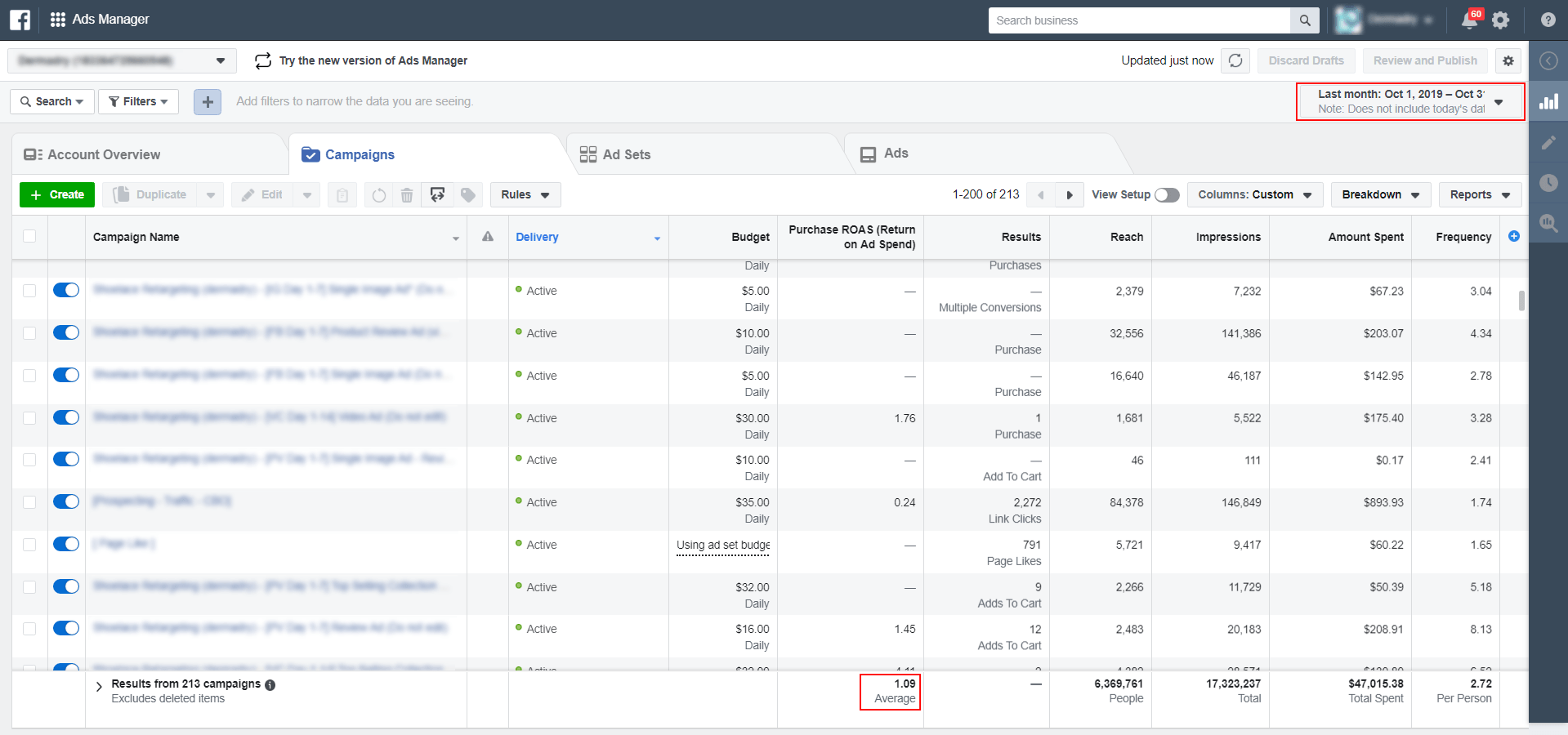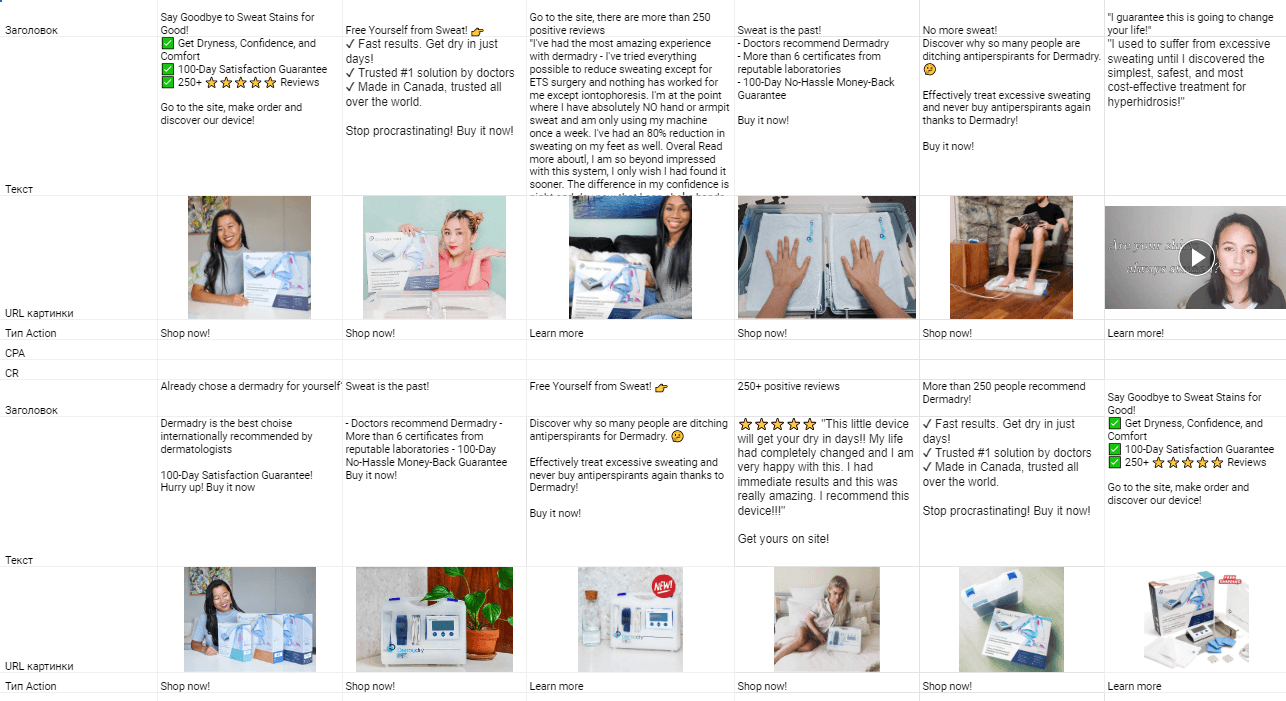Project: The B2C e-commerce project with a quite narrow target audience in the niche of medical equipment.
Geography: Worldwide
Budget: $47 000
ROAS: x3.55
Revenue: 146 000$ for 22 days

What the client came to us with:
80% of the traffic comes from Facebook and Instagram
- Average ROAS for the project = 1.09 during the year
- Average budget $47,000/month
- Absence of tests of used geo, advertising creatives and audience
- Retarget is implemented through external account automation services (which take commissions) or not implemented at all.
- The structure of advertising campaigns is completely absent, and the ad account is in absolute chaos
- Average overlap 50% +
- Regularly ads blocking
Client’s goal:
Increase ROAS to x2 within 3 months and keep the monthly budget intact

Screenshot of the advertising account before the work started
Analytics
We need to start with the main thing:
An understanding of how ROAS is counted. Some people might think that the x2 score is a little low. But you need to take into account the specifics of this project. The target action sent to analytics here is the sale on the site, as the order is placed only after the card is linked and the order is paid for. Consequently, the percentage of refusals or refunds in the end was minimal.
Also this KPI was set by the client, so since he know economic model of his business and understand what KPI is profitable
What we did first of all
First of all, we began to create key audiences planned to be worked with for Retarget and Prospection campaigns. We also prepared new advertising creatives for the tests and created a LAL audience of people who have already bought the product or read articles about it on the site.
What audiences we've chosen
Relying on the client's CJM, we created as many various audience segments as possible. In theory, they could be used in Prospection or Retarget campaigns (later it turned out not to be necessary, but more on that later)
In selecting audiences for Prospection campaigns, we tried to choose the broadest audiences, as they burned out quite fast, and our goal was to create a campaign as close to Evergreen as possible.
For Retargeting we collected all possible Customer Flow from the audiences, as well as segmented some website pages and gathered them in the audiences. Below is the master list with the days in the brackets.
- pageview (15), (30), (90), (180)
- view content (15), (30), (90), (180)
- view content 2+ (15), (30), (90), (180)
- lead (30), (90), (180)
- cart (15), (30), (90), (180)
- initiate checkout (15), (30), (90), (180)
- purchase (15), (30), (90), (180)
- purchase 2+ (180)
- purchase 5+ (180)
- purchase > $50 (180)
- purchase > $100 (180)
- purchase > $200 (180)
Remarketing - Engagement
- engaged fb (3), (60), (365)
- engaged ig (3), (60), (365)
- watched video 75%+ (60), (365)
- watched video 95%+ (60), (365)
I can say such deep segmentation did not bring us the result we expected. We ended up with a much simpler structure, but perhaps the list will give you ideas and be useful in your projects.
High-quality advertising creatives - 80% of success
As a result of client cabinet's study , we did not understand the logic by which the rotation of advertising creatives was created and how they were tested by the previous target manager. So, we chose the best advertising creatives from the ones that had already been used (a few were turned off for some reason) and used them to make new creatives in a little impromptu Communication Grid.
For ourselves, we found with the highest CTR (>1%) are creatives-emotions with customer reviews or plain pictures of products with detailed characteristics.
As you know people don't like to read, so we tried to minimize the amount of text and removed the provoking headlines to avoid blocking.

We also prepared promotional creatives for retargeting.
Trash Cleaning
We couldn't lose budget volume and it made our task more difficult. It would be ideal to turned off most half of the ad campaigns and started tests from scratch with gradual scaling. In order not to lose the budget and to increase ROAS, we firstly disabled all advertising campaigns created by external automation services such as Shoelace and Automate Ads. They took a minor part of the budget, but had no impact, and besides, demanded a large subscription fee for the use of services. We also turned off some of the unprofitable Prospection in favor of the new Retargeting.
Retargeting settings
Since before we started our work, advertising had been running for quite a long time and on the big budgets, a huge amount of different data about visitors had accumulated. So, in the first place the decision was made to start retargeting on higher budgets. Thus, in summary, we had a budget allocation of 60%/40%, where $ 700 per day we spent on retargeting.
At first we tried retargeting for each funnel step with a breakdown by day and substitution of communication at each step, but in the end this idea did not stick. Following we used the simplest possible system of 3 advertising campaigns with a budget allocation of 150$/250$/300$ per day.
Campaign for $150 per day - the standard reminder for people who had already started the process of leaving payment information and for some reason abandoned it.
Campaign for $250 per day - retarget ATC people up to 14 days (a reminder with feedbacks) and after 14 days (here we plugged in discount promotions).
Campaign for $300 per day - retarget the main and info pages.
So, we fundamentally simplified the working system with retargeting campaigns and got a great ROAS, which finally was higher than all Prospection campaigns in the future.
How we tested the creatives at Prospection
Since we had a good enough budget available to test Prospection campaigns (~$900) and Retarget was already working at full throttle, we quietly shut down all unprofitable campaigns and started our own. For each creative was made a separate ad set with a budget of $100 and the same audiences.
Thus, the budget was divided evenly and in two days we had a list of the best ads and transferred them to the CBO.
Risk Management
To protect ourselves from unwanted risk, we added auto-rules that turned off ads if they exceeded the KPIs by:
- Number of sales
- ROAS
Funnel cyclicity
We tried as much as possible to accumulate customers after the purchase on Instagram and Facebook page (to be honest, not very successful). The cross sales in this project were almost impossible, and the average check always remained at $330.
Finally. we gave all these after-sales relations to people dealing with Klavio, and continued to accumulate buyers in social networks on small budgets.
Result
✅ ROAS = 3.55 with attribution window 7 days after click and 1 day after view
✅$146 000 revenue in 22 days
✅Starting to prepare ads for Black Friday
✅Completely redesigned Prospection and Retarget structure.
✅Clickability of creatives has been multiplied.
✅Created the simplest possible structure, which is easily manageable and scalable.
✅All unprofitable third-party automation services are disabled.

Project Team
Get started on the project
A great way to start getting to know your business - just to call. Leave a form, and we will delve into your enterprise challenges and offer the best solutions.